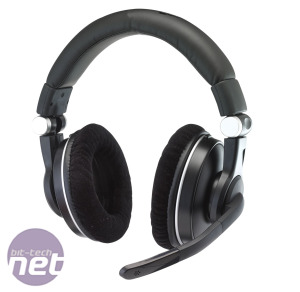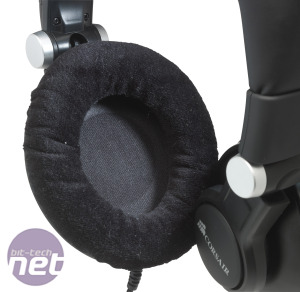Corsair HS1A Review
Manufacturer: CorsairUK price (as reviewed): £39.95 (inc VAT)
US price (as reviewed: $74.99 (ex tax)
The HS1A is Corsair's follow-up to the HS1 headset, but replaces its predecessor's USB connector with a more conventional pair of 3.5mm mini-jacks for the benefit of a £17 price cut.
Both the HS1 and the HS1A have 50mm drivers housed in large, comfortable circumaural ear cups, which are closed-back in design. The only difference between the two is that the HS1A's cups are black, while the HS1's cups are silver. These ear cups are connected by the same thick, soft headband that we saw on the HS1 and, as a result, are equally comfortable. This is a real boon, as the level of comfort that the HS1 set offered was one of our favourite features.
Further enhancing the comfort level are the soft, microfibre-covered memory foam ear pads, which do an excellent job of sealing out external noise. Also bundled with the HS1A is an additional pair of leatherette-covered ear pads - an extra that the more expensive HS1 set lacks.
The only other difference between the HS1A and the HS1 is the fact that the HS1A's cable terminates in a pair of 3.5mm jacks. These connect to the microphone and headphones and replace the USB connector with which the HS1 is equipped.
This means that the HS1A misses out on the positional audio emulation of Dolby Headphone that was included with the HS1's on-board USB audio processor. Considering the price difference between the two sets, this shows just how much of a royalty Dolby must demand from headset makers for such support.
We didn't mourn the loss of Dolby Headphone support, though, as the use of analogue connectors enabled us to plug the headset into any sound card or 3.5mm output. This meant we could take advantage of the dedicated Asus Xonar DX sound card and its own 3D-positional emulation in our test rig. We also didn't need to install any extra Dolby Headphone drivers.
The HS1A is also very similar to the HS1 acoustically, which is both pleasing and frustrating at the same time. The clarity and acuity of the sound produced by the headset was brilliant, with clear mid and high tones; as with its sibling, though, this quality and depth wasn't replicated in the bass scale.
It's a frustrating arrangement, as the quality of the high-end throws the lack of bass into sharp relief. This sound profile meant that piano or acoustic music sounded bright and alive, while heavier rock or drum and bass tracks appeared tinny and underwhelming.
The guns and grenades in Call of Duty 4: Modern Warfare also sounded distinctly tinny compared to other headsets we've used recently. Dirt 2 fared equally badly, with the throaty roar of our rally car's exhaust sounding more like an effeminate whine.
Adding a little bass-boost to the audio via the Windows 7 control panel helped matters, but resulted in a loss of volume. Even with everything dialled up to full, the HS1A's audio output level was only moderate at best. You may have more luck if you dive into your soundcard's EQ options, but that will vary depending on your system.
Conclusion
The HS1A is very comfortable, and has excellent sound clarity and detail. Unfortunately, it lacks the bass depth that provides the wow factor in games, music and movies. This can be dialled out with a bit of fiddling with EQ balances, though, making it a minor complaint for such a keenly priced and high-quality headset. The next step up the audio scale is the Razer Carcharias, which costs around £70, making the Corsair HS1A a bargain.
-
Value26 / 30
-
Design27 / 30
-
Sound Quality32 / 40


MSI MPG Velox 100R Chassis Review
October 14 2021 | 15:04













Want to comment? Please log in.